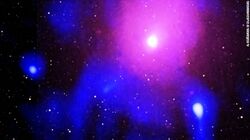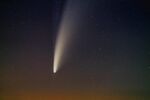Astronomy:Ophiuchus Supercluster eruption
According to NASA and others[who?], the Ophiuchus Supercluster eruption in the galaxy NeVe 1 was the biggest AGN outburst seen in the observable universe since the MS 0735+74 outburst.[1][2][3]
| Event type | AGN outburst |
|---|---|
| Instrument | Chandra X-ray Observatory, XMM-Newton, Murchison Widefield Array, Giant Metrewave Radio Telescope |
| Constellation | Ophiuchus |
| Distance | 390 million light-years |
This extremely energetic event occurred in the Ophiuchus Supercluster, which is located about 390 million light-years from Earth. This eruption was caused by a supermassive black hole spraying out jets of extremely active particles over hundreds of millions of years.[4][5] The total energy is estimated to be 5 × 1061 erg, or 5 × 1054 J; but this likely an underestimate due to uncertainty of the cavity's size.[6]
This observation is a result of collaboration among various space-based and Earth-based observatories including the Hubble Space Telescope, the Chandra X-ray Observatory, ESA’s XMM Newton X-ray space observatory and radio data from the Murchison Widefield Array (MWA) in Australia and the Giant Metrewave Radio Telescope (GMRT) in India.[7][8]
References
- ↑ "Ophiuchus Galaxy Cluster". NASA. 27 February 2020. https://www.nasa.gov/mission_pages/chandra/images/ophiuchus-galaxy-cluster.html.
- ↑ "Chandra Press Room :: Most Powerful Eruption in the Universe Discovered :: January 5, 2005". https://chandra.harvard.edu/press/05_releases/press_010505.html.
- ↑ "The AGN Outburst we won't call an explosion and a rock around the Earth | The Daily Space" (in en-US). https://cosmoquest.org/x/dailyspace/2020/02/28/the-agn-outburst-we-wont-call-an-explosion-and-a-rock-around-the-earth/.
- ↑ Werner, N.; Zhuravleva, I.; Canning, R. E. A.; Allen, S. W.; King, A. L.; Sanders, J. S.; Simionescu, A.; Taylor, G. B. et al. (August 2016). "Deep Chandra study of the truncated cool core of the Ophiuchus cluster" (in en). MNRAS 460 (3): 2752–2764. doi:10.1093/mnras/stw1171. ISSN 0035-8711. Bibcode: 2016MNRAS.460.2752W.
- ↑ "Universe's Most Powerful Black Hole Eruption Spotted | Astronomy | Sci-News.com" (in en-US). http://www.sci-news.com/astronomy/ophiuchus-cluster-eruption-08173.html.
- ↑ Giacintucci, S.; Markevitch, M.; Johnston-Hollitt, M.; Wik, D. R.; Wang, Q. H. S.; Clarke, T. E. (4 February 2020). "Discovery of a giant radio fossil in the Ophiuchus galaxy cluster". The Astrophysical Journal 891 (1): 1. doi:10.3847/1538-4357/ab6a9d. Bibcode: 2020ApJ...891....1G.
- ↑ "Biggest cosmic explosion ever detected left huge dent in space". The Guardian. 27 February 2020. https://www.theguardian.com/science/2020/feb/27/biggest-cosmic-explosion-ever-detected-makes-huge-dent-in-space.
- ↑ Giacintucci, S.; Markevitch, M.; Johnston-Hollitt, M.; Wik, D. R.; Wang, Q. H. S.; Clarke, T. E. (2020-02-04). "Discovery of a giant radio fossil in the Ophiuchus galaxy cluster". The Astrophysical Journal 891 (1): 1. doi:10.3847/1538-4357/ab6a9d. Bibcode: 2020ApJ...891....1G.





